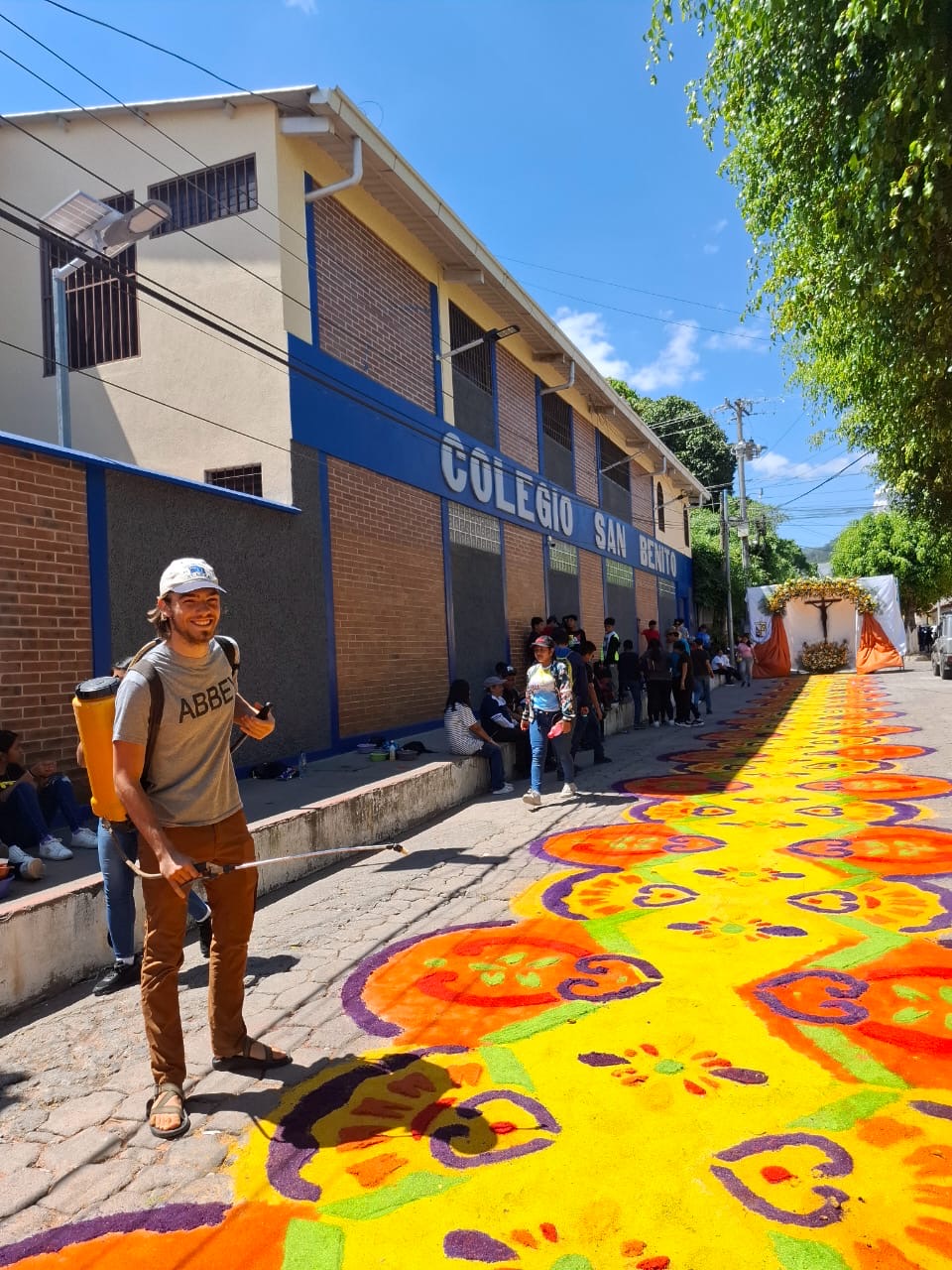
Well, well, well! I think it goes without saying that the only way I could really start this post is by giving a big fat apology, as yet again I have left you all with a hefty delay between entries, and for that I really am quite sorry. I guess the work at school has gotten ahead of me, and I’ve been using my time in between to do things other than updating the lovely people who read this blog (and you all are quite lovely indeed). Nonetheless, I’m sure none of you came here to watch me grovel and apologize for not making a post, but rather to actually hear about what’s been going on in my life. So, without further ado here’s the tale of a fun event that happened just about a month ago which I’ve been meaning to recap on this website for a long time. Once again (and for the last time), sorry for the delay in getting this out there.
The events of the ninth of March are what I’d like to regale you with today. March 9th is an important day for me personally as it is my wonderful mother’s birthday (shoutouts to you if you are reading this Mom), but it turns out it is also quite a special day here in Esquipulas. March 9th is the day that commemorates when the famous image of the Cristo Negro, aka. El Señor de Esquipulas, officially arrived in this fair town after a sixth month journey from the former capital city of Guatemala, now known as Antigua Guatemala. To commemorate this event every year there is a procession in which a reproduction of the crucified Jesus is carried across the town to various sites throughout the day before coming to rest in front of the basilica at night, where a large fireworks show is held. The procession is in itself a very unique spectacle and something that I could talk about for a while, but what really made this day exciting for me was the alfombras.
“What is an alfombra?” I hear you asking. Well, for those of you who haven’t been practicing your Spanish, “alfombra” means “rug” and it is a huge tradition in Guatemala to make alfombras or “rugs” for religious processions across the country. Of course, these rugs are not what you would think of in the traditional sense. Most alfombras are giant works of art made with colored sawdust, though some are also made with salt that is colored. These creations are then trodden on by the processions, destroying them in the process. My experience of March 9th was particularly special because I got to be directly involved with the process of preparing, creating, and destroying a Guatemalan style alfombra.
The whole process started two days before the actual procession. Before we could even begin making the alfombra we first had to prepare the materials for it. This of course included a large quantity of sawdust, all of which needed to be colored. This was primarily done by the students from the 5th grade of the school (roughly equivalent to sophomore year in high school), with assistance from me and Fredi. Essentially, all we had to do was combine sawdust and powdered dye, and mix it all together. The quantity of dye used in comparison with the quantity of sawdust was quite lopsided. I’d estimate that there were maybe only 3 or 4 tablespoons of powdered dye used for roughly 30-50 pounds of sawdust, one large pile for each color of the rainbow. The dye was activated by water which was poured over the piles, and we had to spend a long time mixing it up with our hands. The dye stuck to our skin just as much as it stuck to the sawdust and all of our hands were beautifully colored by the end of the afternoon (next time I’ll invest in a pair of gloves). I was lucky enough to work on the lime green pile, and had a fun time making jokes with my students about me turning into Shrek. After the sawdust was colored it was collected and bagged up, ready to be used on the day of the procession.


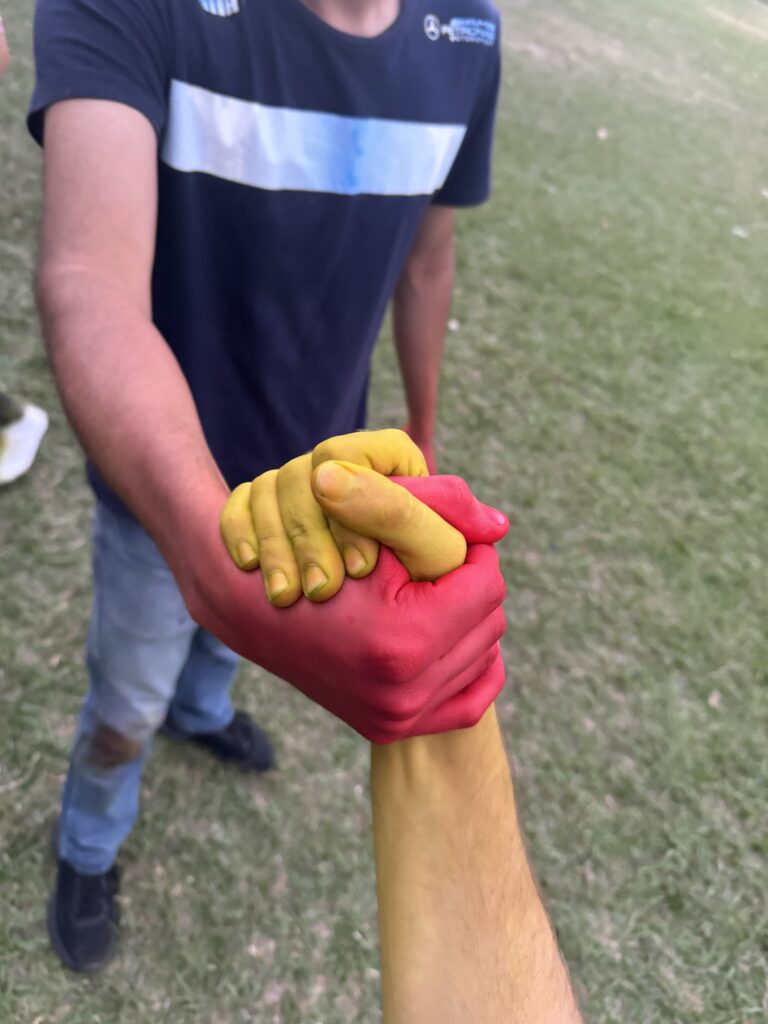
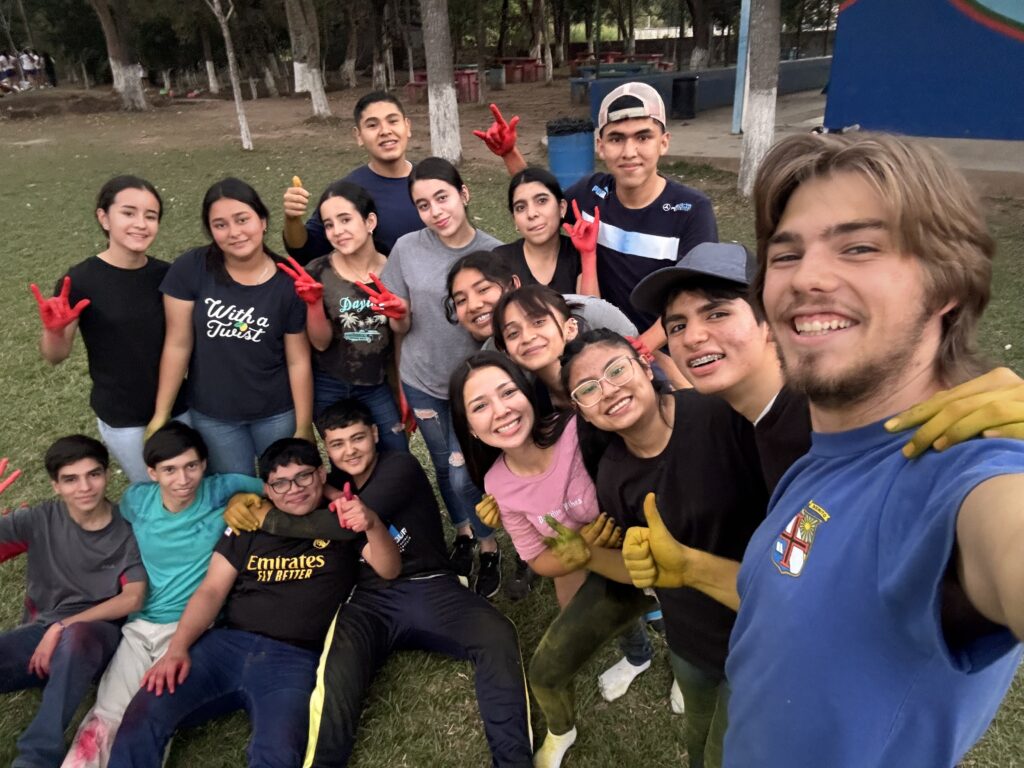
March 9th started early, with most of the students arriving at school at 6:00 AM to start preparing the alfombra. (This entire job was done by students who attend classes in the afternoon, with each class section being responsible for building one section of the alfombra.) The first step was to level off the ground on which we were going to build the alfombra, on the street in front of the school. This was done by packing uncolored sawdust in the gaps between the cobblestones on the street. After this was done the base layer was laid down, mainly using orange, lime green, and yellow sawdust. This was probably the longest step since it used the most material by far, and the lines needed to be very straight and accurate in order to properly make the design that was intended. Chalk lines which had been drawn onto the street at the very beginning of the day helped the students stay within the boundaries of the design. Fredi and I got to help pack in these large colored sections of sawdust, and I found it very satisfying filling in the template that had been lined in chalk on the ground.

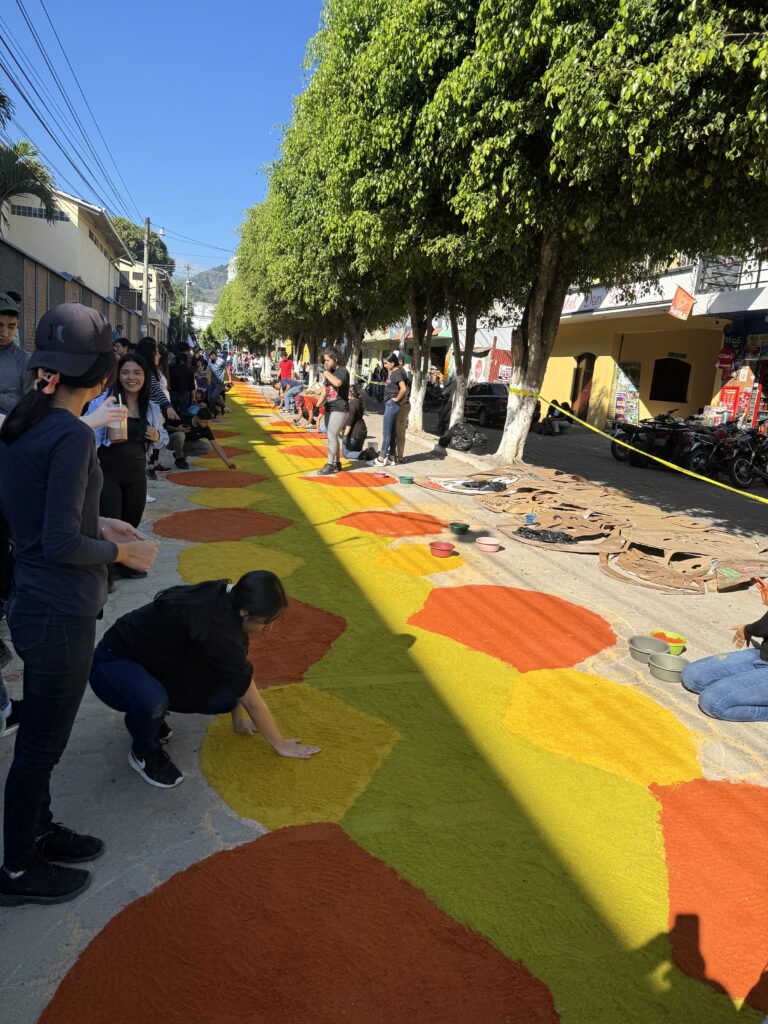
After the base layer was in place across the whole stretch of road in front of the school, a giant cardboard stencil was placed down over the length of the alfombra. This step took a long time as they wanted to be very sure that the stencil was in the exact right spot before any sawdust could be put into the stencil holes. Next of course these holes were filled in using a variety of colors including purple, orange, bright red and dark green. The overall pattern of the final alfombra was like a colorful runway covered in organic- shaped accents (see the photos below). Once the stencil was lifted off, small errors had to be corrected, and then the alfombra was basically done. While the students waited for the procession to arrive and walk over the alfombra, several students (and myself) took shifts spraying the alfombra down with water, so that it would not be blown away by the wind. This whole process, from outlining, to base- applying, to decoration took several hours, with everything being done around 11:00 AM. After this Fredi and I got the chance to walk around Esquipulas with a group of teachers to see some of the other alfombras that people across town had made. Take a look below!
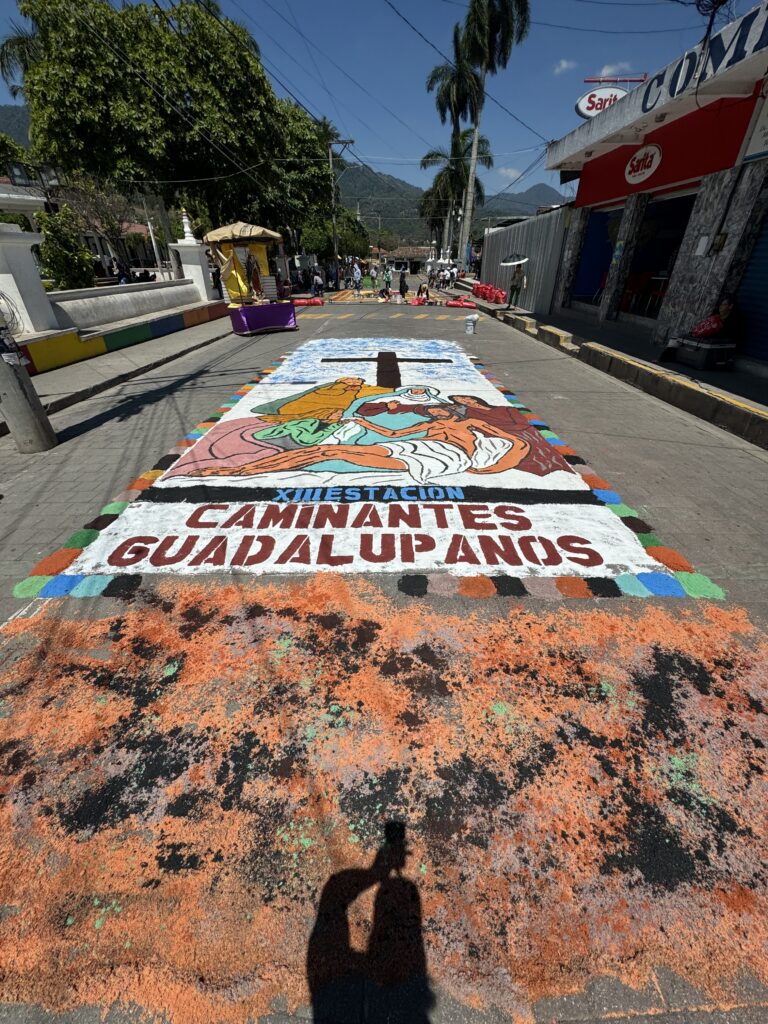
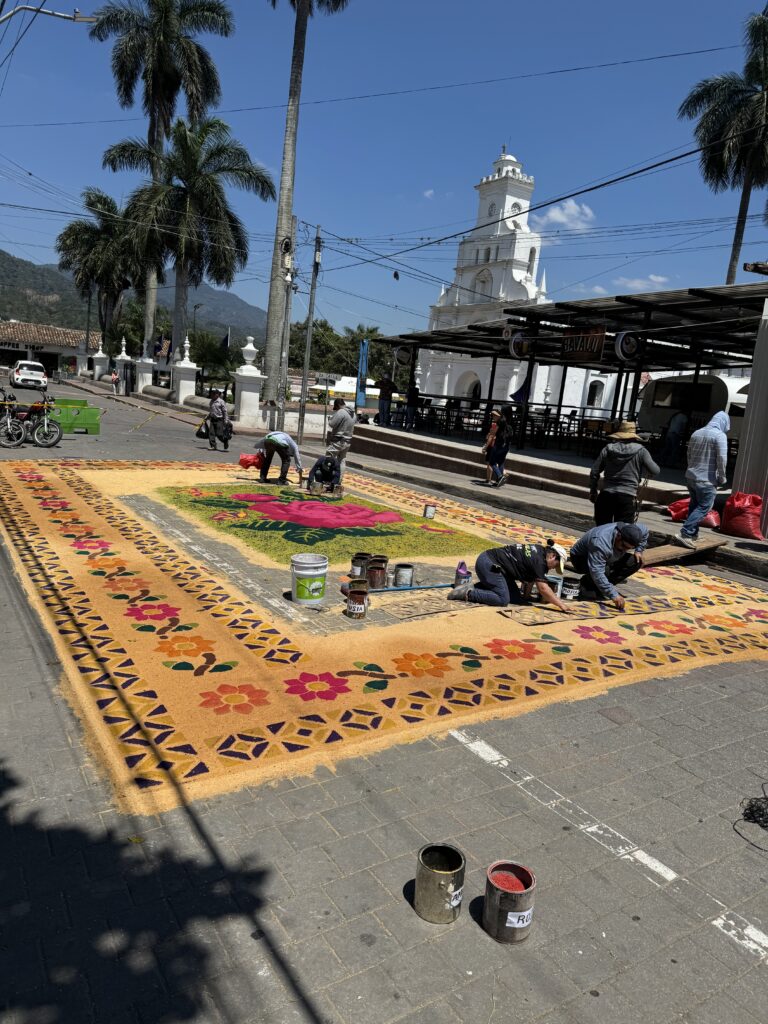
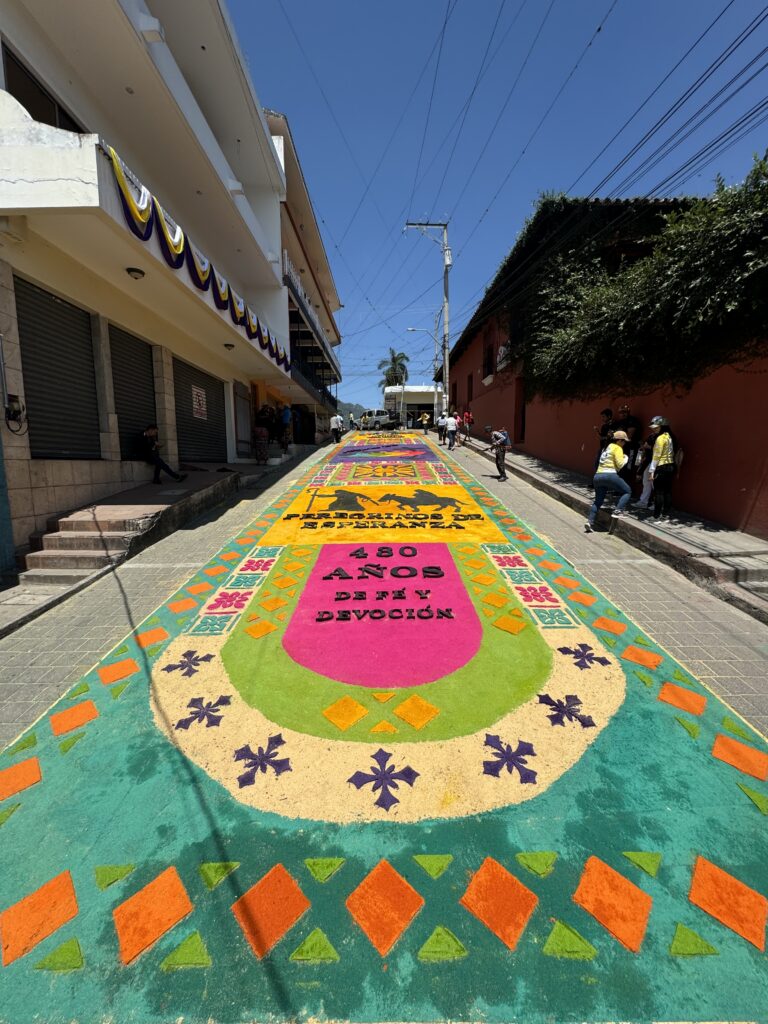
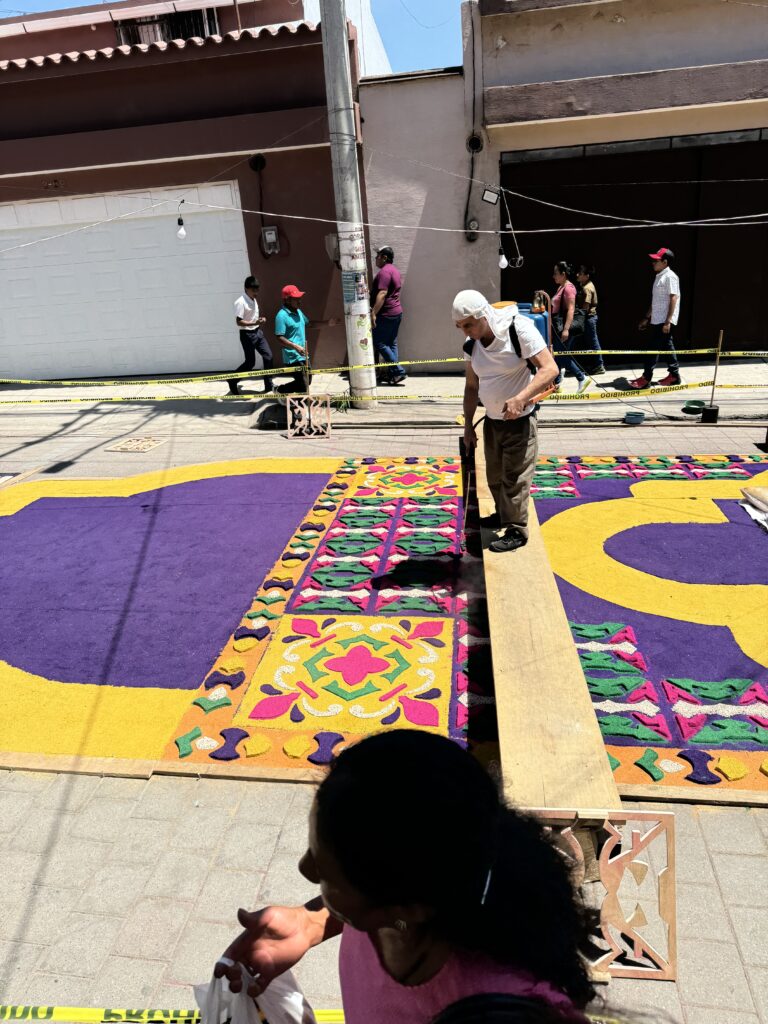

After eating lunch, we had to wait a few hours for the procession to arrive. Wherever an alfombra was, there was also usually a small shrine erected on the side of the road, and the procession would usually stop and say a few prayers before moving on. It was a long process, and we had to wait quite a while for the procession to arrive. Once it finally did arrive, the environment in front of colegio San Benito became a very festive. A choir of students began to sing, and a massive flock of pilgrims began to walk by on the street as the procession approached. Additionally, the approach was periodically announced with someone lighting off fireworks, which served not only to announce what was coming, but also assured me that my heart was indeed still working. Once the procession arrived in front of the school, several students took over carrying the “float” with the reproduction image of the Cristo Negro on it. It took about 30 people to lift the “float”, and I can’t even begin to imagine how heavy it must have been. Then they tread over the work of art that we had made that morning, turning it back into the formless dust that it started as. The procession then stopped at the front of our alfombra where the school had erected a small shrine and Padre Hugo (one of the monks of the monetary) as well as one of the priests of the diocese read from the gospel in front of the crowd and said several prayers of thanks and of commemoration for the 430 years of faith and dedication in Esquipulas. It was quite a sight to see
Many of you might be reading all this and thinking “what the heck, why would they spend all that time under a hot sun making this big work of art, only for it to be destroyed a few hours later?” That is certainly a valid question, and it was my initial reaction when I first heard of this unique custom. However, after a month reflecting on this event, I think I have a pretty good take on why this is such a cool thing.
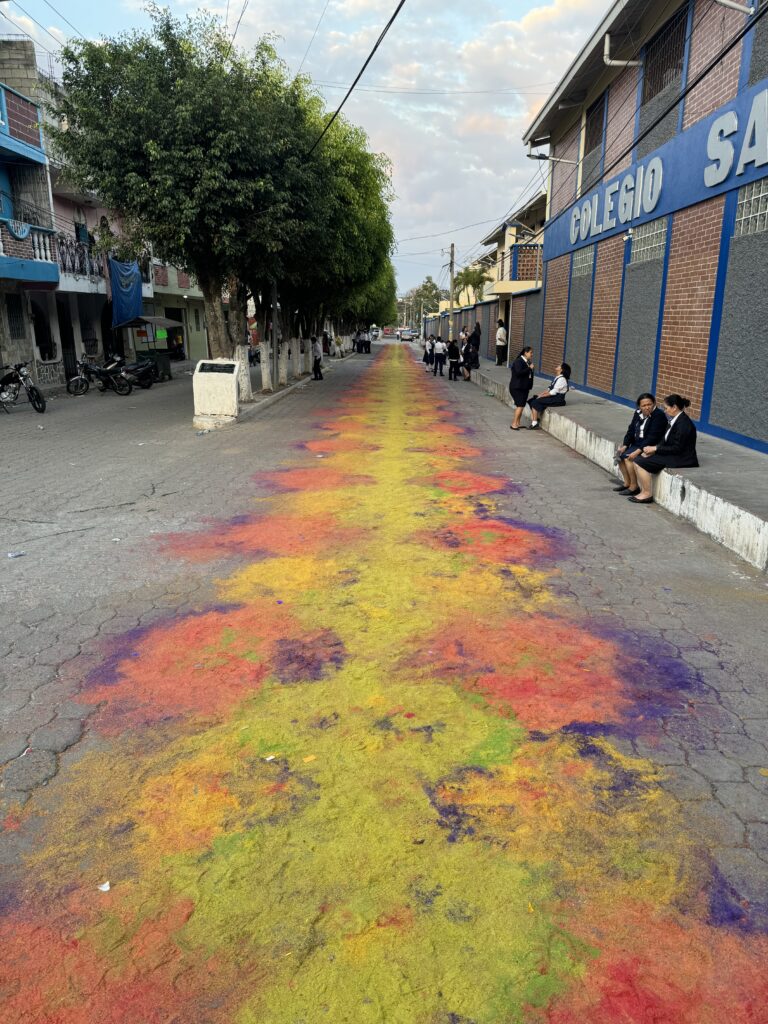
Those of you familiar with sand mandalas might already know where I’m going to go with this, but I think that the creation and destruction of the alfombra is a great reminder of the impermanence of things in our lives. Most alfombras in this country are made for religious processions that take place during lent, a time which begins on Ash Wednesday with the ever-persistent reminder that “all come from dust, and all return to dust”. The creation of a beautiful work of art from mere dust, and its subsequent scattering and destruction, is a powerful reminder that nothing made by humans is eternal. Some might take such a statement and think to themselves, “well if all is doomed to destruction, I may as well not try, or I may as well give up”, however, I have reached a much different conclusion.
The street on which we made our alfombra was nothing important or impressive on March 8th. It was just a group of cobblestones that provided a lane for people and vehicles to traverse. However, in just one day, a group of humans transformed it into something wonderful. In a few short hours, it became an object of beauty that brought a community together and served to guide people’s minds and hearts during a spiritual event. It became so much more than a pile of cobblestones. Yet if it had stayed on the street forever, only to be admired by people not involved in its creation, and if it had not been trodden on and destroyed, I think it would have been much less significant. The art was impermanent, and that was exactly what made it wonderful. When I look at it this way, I cannot help but make the connection that our own impermanence does not remove the meaning from our lives, rather it is exactly what GIVES meaning to our lives.
Perhaps I’m looking into this whole thing a bit too much, but hey, if I didn’t want to take some time to slow my life down and reflect on the things in my life, be they mundane or extraordinary, I wouldn’t have joined the BVC. If within our short lives we have the chance to be like that spread of sawdust on the ground; to become something or someone who evokes a sense of beauty in this world, who brings people together, who inspires others- even if it is for a mere blink in the eye of the universe- I think we might just be beginning to do what we were created to do.
Yet it is not our part to master all the tides of the world, but to do what is in us for the succor of those years wherein we are set, uprooting the evil in the fields that we know, so that those who live after may have clean earth to till. What weather they shall have is not ours to rule
J.R.R Tolkien
